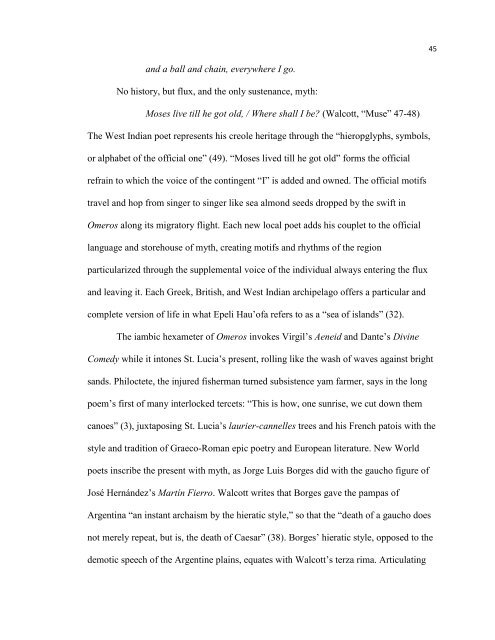RE-INHABITING THE ISLANDS - The University of North Carolina at ...
RE-INHABITING THE ISLANDS - The University of North Carolina at ...
RE-INHABITING THE ISLANDS - The University of North Carolina at ...
You also want an ePaper? Increase the reach of your titles
YUMPU automatically turns print PDFs into web optimized ePapers that Google loves.
45<br />
and a ball and chain, everywhere I go.<br />
No history, but flux, and the only sustenance, myth:<br />
Moses live till he got old, / Where shall I be? (Walcott, ―Muse‖ 47-48)<br />
<strong>The</strong> West Indian poet represents his creole heritage through the ―hieropglyphs, symbols,<br />
or alphabet <strong>of</strong> the <strong>of</strong>ficial one‖ (49). ―Moses lived till he got old‖ forms the <strong>of</strong>ficial<br />
refrain to which the voice <strong>of</strong> the contingent ―I‖ is added and owned. <strong>The</strong> <strong>of</strong>ficial motifs<br />
travel and hop from singer to singer like sea almond seeds dropped by the swift in<br />
Omeros along its migr<strong>at</strong>ory flight. Each new local poet adds his couplet to the <strong>of</strong>ficial<br />
language and storehouse <strong>of</strong> myth, cre<strong>at</strong>ing motifs and rhythms <strong>of</strong> the region<br />
particularized through the supplemental voice <strong>of</strong> the individual always entering the flux<br />
and leaving it. Each Greek, British, and West Indian archipelago <strong>of</strong>fers a particular and<br />
complete version <strong>of</strong> life in wh<strong>at</strong> Epeli Hau‘<strong>of</strong>a refers to as a ―sea <strong>of</strong> islands‖ (32).<br />
<strong>The</strong> iambic hexameter <strong>of</strong> Omeros invokes Virgil‘s Aeneid and Dante‘s Divine<br />
Comedy while it intones St. Lucia‘s present, rolling like the wash <strong>of</strong> waves against bright<br />
sands. Philoctete, the injured fisherman turned subsistence yam farmer, says in the long<br />
poem‘s first <strong>of</strong> many interlocked tercets: ―This is how, one sunrise, we cut down them<br />
canoes‖ (3), juxtaposing St. Lucia‘s laurier-cannelles trees and his French p<strong>at</strong>ois with the<br />
style and tradition <strong>of</strong> Graeco-Roman epic poetry and European liter<strong>at</strong>ure. New World<br />
poets inscribe the present with myth, as Jorge Luis Borges did with the gaucho figure <strong>of</strong><br />
José Hernández‘s Martín Fierro. Walcott writes th<strong>at</strong> Borges gave the pampas <strong>of</strong><br />
Argentina ―an instant archaism by the hier<strong>at</strong>ic style,‖ so th<strong>at</strong> the ―de<strong>at</strong>h <strong>of</strong> a gaucho does<br />
not merely repe<strong>at</strong>, but is, the de<strong>at</strong>h <strong>of</strong> Caesar‖ (38). Borges‘ hier<strong>at</strong>ic style, opposed to the<br />
demotic speech <strong>of</strong> the Argentine plains, equ<strong>at</strong>es with Walcott‘s terza rima. Articul<strong>at</strong>ing
















